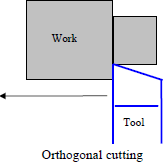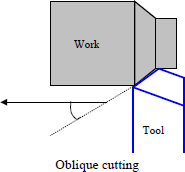Difference between Orthogonal and Oblique Cutting
Contents
Comparison between Orthogonal and Oblique Cutting
Summary:
The major difference between orthogonal and oblique cutting is that in orthogonal cutting, the cutting edge of the tool is perpendicular to the direction of motion. In oblique cutting the cutting edge makes an angle with the direction of motion.

Comparison Chart
| Orthogonal Cutting | Oblique Cutting |
|---|---|
| The cutting edge of the tool remains normal to the direction of tool feed or work feed. | The cutting edge of the tool remains inclined at an acute angle to the direction of tool feed or work feed. |
| The cutting edge of the tool remains inclined at an acute angle to the direction of tool feed or work feed. |
The direction of the chip flow velocity is at an angle with the normal to the cutting edge of the tool. The angle is known as the chip flow angle. |
| Here only two components of forces are acting: Cutting Force and Thrust Force. So the metal cutting may be considered as a two-dimensional cutting | Here three components of forces are acting: Cutting Force, Radial force, and Thrust Force or feed force. So the metal cutting may be considered as a three-dimensional cutting. |
| The cutting edge being non-oblique, the shear force acts on a smaller area and thus tool life is decreased. | The cutting edge being oblique, the shear force acts on a larger area and thus tool life is increased |
| cutting edge is larger than cutting width. | Cutting edge may or may not be larger than cutting width. |
| The flow of the chip is perpendicular to cutting edge. | The flow of chip is not perpendicular to cutting edge |
| The tool has a lesser cutting life. | The tool has a lesser cutting life. |
 |
 |
More Differences
- Difference Between Belt Drive, Chain Drive and Gear Drive
- Difference Between Flat Belt Drive and V-Belt Drive
